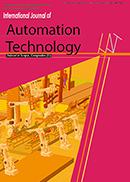Volume 17, Issue 2
Displaying 1-12 of 12 articles from this issue
- |<
- <
- 1
- >
- >|
Special Issue on Application of Artificial Intelligence Techniques in Production Engineering
-
Article type: Editorial
2023Volume 17Issue 2 Pages 91
Published: March 05, 2023
Released on J-STAGE: March 05, 2023
Download PDF (124K) -
Article type: Research Paper
2023Volume 17Issue 2 Pages 92-102
Published: March 05, 2023
Released on J-STAGE: March 05, 2023
Download PDF (5024K) -
Article type: Research Paper
2023Volume 17Issue 2 Pages 103-111
Published: March 05, 2023
Released on J-STAGE: March 05, 2023
Download PDF (4965K) -
Article type: Research Paper
2023Volume 17Issue 2 Pages 112-119
Published: March 05, 2023
Released on J-STAGE: March 05, 2023
Download PDF (2310K) -
Article type: Research Paper
2023Volume 17Issue 2 Pages 120-127
Published: March 05, 2023
Released on J-STAGE: March 05, 2023
Download PDF (2970K) -
Article type: Research Paper
2023Volume 17Issue 2 Pages 128-135
Published: March 05, 2023
Released on J-STAGE: March 05, 2023
Download PDF (5081K) -
Article type: Research Paper
2023Volume 17Issue 2 Pages 136-143
Published: March 05, 2023
Released on J-STAGE: March 05, 2023
Download PDF (2746K) -
Article type: Research Paper
2023Volume 17Issue 2 Pages 144-155
Published: March 05, 2023
Released on J-STAGE: March 05, 2023
Download PDF (4451K) -
Article type: Research Paper
2023Volume 17Issue 2 Pages 156-166
Published: March 05, 2023
Released on J-STAGE: March 05, 2023
Download PDF (1890K) -
Article type: Research Paper
2023Volume 17Issue 2 Pages 167-175
Published: March 05, 2023
Released on J-STAGE: March 05, 2023
Download PDF (2827K) -
Article type: Research Paper
2023Volume 17Issue 2 Pages 176-182
Published: March 05, 2023
Released on J-STAGE: March 05, 2023
Download PDF (2403K)
Regular Papers
-
Article type: Research Paper
2023Volume 17Issue 2 Pages 183-193
Published: March 05, 2023
Released on J-STAGE: March 05, 2023
Download PDF (1439K)
- |<
- <
- 1
- >
- >|
